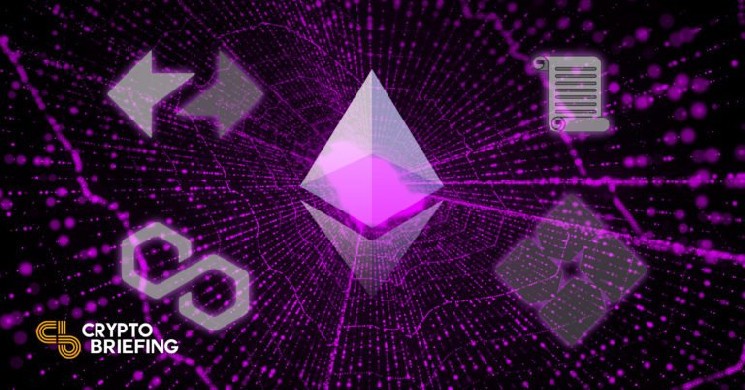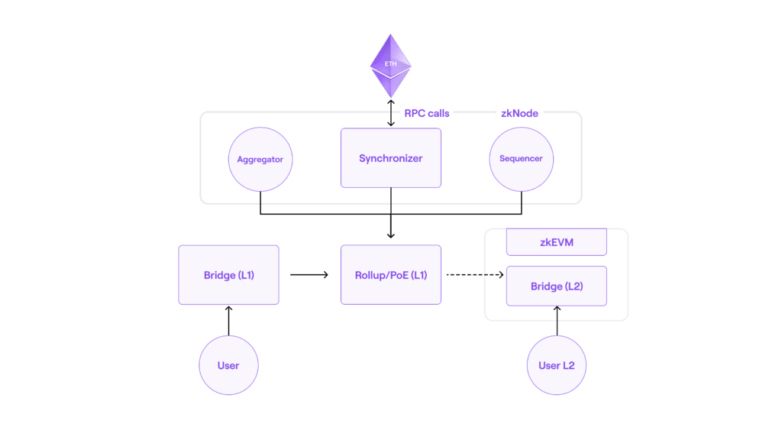The Race to Scale Ethereum With zkEVM Rollups

As Ethereum sets its sights on mass adoption, ZK-Rollup technology has emerged as a strong contender for scaling the blockchain, lowering transaction costs, and improving throughput. Crypto Briefing breaks down four major ZK-Rollups compatible with the Ethereum Virtual Machine that are currently under development, each of which promises various advantages within the Ethereum ecosystem.
Tackling Ethereum’s Transaction Fees
Ethereum is facing scaling challenges.
Perhaps the single biggest barrier to widespread Ethereum adoption is the high cost of using the network, which has become an existential issue for the blockchain.
The rise of DeFi protocols and NFTs has increased the demand for block space on Ethereum. Most transactions cost a few cents in 2019, but during the peak of the 2021 bull run, activities like minting NFTs on the blockchain would regularly come in at hundreds of dollars. As a result, many retail market participants found they were priced out of the network and turned to other networks like Solana, Avalanche, or Binance Smart Chain. Today, despite a downturn in network activity due to market conditions, simple transactions such as ETH transfers cost between $2 and $3, well above Ethereum creator Vitalik Buterin’s ideal goal of less than $0.05 per transaction.
Rollups offer a way to relieve congestion on the Ethereum blockchain. That’s because they outsource data off-chain, process it, and send transactions back to Ethereum rather than relying on the base chain to process each transaction’s computational data. With rollups, Ethereum only has to verify the proofs themselves and not the entirety of the data, which frees up block space. Rollups also allow transactions to be bundled together, which allows users to split gas fees.
Zero-Knowledge Rollups, also known as ZK-Rollups, use cryptographic proofs called ZK-SNARKS (“zero knowledge succinct arguments of knowledge”) to show to Ethereum mainnet that a transaction was processed. These zero-knowledge proofs can be verified quickly even though the underlying data would take a long time to analyze.
Some ZK-Rollup projects currently under development have announced their intention to be compatible with the Ethereum Virtual Machine, offering Ethereum developers a way to import their smart contracts to the rollup without modifying them. But as Buterin explained in a recent blog post, not all zkEVM projects are structured the same way: some optimize for complete EVM composability, and others for rapid throughput.
zkSync
Developed by Matter Labs, zkSync is one of the most anticipated zkEVM projects. Boasting 2,000 transactions per second, a 10-minute processing time between the rollup and Ethereum mainnet, and no upper bound limit to the value the rollup can securely handle, zkSync is a leading project in the field of zkEVMs.
Despite its marketing, zkSync isn’t technically compatible with the EVM, but rather with Solidity and Vyper, two coding languages used on Ethereum. The difference, while small for users, is important for developers: among other things, contract addresses may differ, handwritten EVM code may not be supported, and debugging infrastructure may not necessarily be carried over.
The rollup is currently live on Ethereum’s testnet. The mainnet launch is expected to happen in three steps: “Baby Alpha” in November, during which the system will be put through real-money stress tests with no external projects involved; the Fair Launch, which will welcome all Ethereum ecosystem projects but keep user access limited; and the Full Alpha, expected before the year’s end. A zkSync token is expected, though details have not yet been announced.
StarkNet
StarkWare’s StarkNet is another major contender in the zkEVM arena. While StarkNet uses Cairo as its native coding language, a team is developing a Solidity to a coding translator called Cairo transpiler, meaning that, just like zkSync, the rollup will eventually be Solidity-compatible rather than EVM-compatible.
Yet the similarities end there. StarkNet uses a different kind of cryptographic proof called STARKs (“scalable transparent arguments of knowledge”). ZK-STARKs are theoretically more secure than ZK-SNARKs but take longer to verify, take up more block space, and require more gas. StarkWare is the main driving force behind STARK-based technology development.
A permissioned version of StarkNet went live on Ethereum mainnet in February 2022. The StarkWare team also announced recently that StarkNet will have its own governance and utility token. While there are no official figures on StarkNet’s anticipated throughput at full capacity, StarkWare says the rollup could reduce gas fees on Ethereum by a factor of 100 to 200.
Polygon zkEVM
Polygon is an Ethereum scaling solution with a flexible framework that allows developers to build and connect Layer 2 infrastructure such as Optimistic Rollups and ZK-Rollups to the Ethereum network. In August 2021, Polygon acquired the ZK-Rollup project Hermez Network for $250 million; the firm announced a year later that it was working on its own ZK-Rollup, Polygon Hermez, which would work alongside its Proof-of-Stake Matic chain. Last month, Polygon announced that Polygon Hermez had rebranded to Polygon zkEVM and would head to mainnet in early 2023.
Polygon claims that its zkEVM will be able to handle up to 2,000 transactions per second and reduce transaction costs by 90%. The project’s code has been made open-source; a public testnet is expected soon.

Source: Polygon
Contrary to zkSync or StarkNet, Polygon’s ZK-Rollup does not intend to limit itself by being compatible solely with Ethereum coding languages, but with the EVM itself. Polygon zkEVM replicates the EVM rather than mirroring it. This implies that builders may still need to adapt code and tooling frameworks to the rollup, though to a lesser extent than on zkSync and StarkNet.
Alongside its ZK-EVM project, Polygon is also developing an Optimistic Rollup (Polygon Nightfall), a STARK-based ZK-Rollup (Polygon Miden), and a speed-optimized EVM-compatible ZK-Rollup called Polygon Zero.
Scroll
The ZK-Rollup aiming for the best integration with the EVM is Scroll. A relatively new project, Scroll can be considered truly EVM-equivalent; the only meaningful difference between the two is the runtime environment, meaning the subsystem in which contracts are executed. However, the high composability comes at the price of a significant computational overhead, which indicates Scroll’s performance could be weaker than that of zkSync, StarkNet, and Polygon.
The Scroll team has yet to release details about the project, but on July 18, it called on developers to register to try the Scroll testnet, which is expected in Q3 2022. The Scroll team is developing the project in collaboration with the Ethereum Foundation. The website claims that security, transparency, and EVM-equivalence are its top priorities.
More ZK-Rollups
Other groups researching ZK-Rollups include the Ethereum Foundation’s Privacy and Scaling Explorations team and an as-of-yet unnamed initiative affiliated with ConsenSys. Though research may contribute to existing projects and not necessarily lead to new ones, the recent breakthroughs in zero-knowledge proof technology may give rise to multiple ZK-Rollups in the Ethereum ecosystem. Though the Ethereum network still has a long road ahead when it comes to scaling, the rise of new zkEVM projects should benefit developers and users alike as they are presented with more solutions catering to different use cases.
Disclosure: At the time of writing, the author of this piece owned ETH and several other cryptocurrencies.






 Bitcoin
Bitcoin  Ethereum
Ethereum  Tether
Tether  USDC
USDC  TRON
TRON  Dogecoin
Dogecoin  Cardano
Cardano  Bitcoin Cash
Bitcoin Cash  Chainlink
Chainlink  LEO Token
LEO Token  Monero
Monero  Stellar
Stellar  Zcash
Zcash  Litecoin
Litecoin  Hedera
Hedera  Dai
Dai  Cronos
Cronos  OKB
OKB  Tether Gold
Tether Gold  Ethereum Classic
Ethereum Classic  KuCoin
KuCoin  Gate
Gate  Algorand
Algorand  Cosmos Hub
Cosmos Hub  VeChain
VeChain  Dash
Dash  Tezos
Tezos  Stacks
Stacks  TrueUSD
TrueUSD  IOTA
IOTA  Basic Attention
Basic Attention  Decred
Decred  Theta Network
Theta Network  NEO
NEO  Qtum
Qtum  Synthetix
Synthetix  Ravencoin
Ravencoin  0x Protocol
0x Protocol  DigiByte
DigiByte  Zilliqa
Zilliqa  Nano
Nano  Numeraire
Numeraire  Siacoin
Siacoin  Waves
Waves  Ontology
Ontology  Enjin Coin
Enjin Coin  Status
Status  BUSD
BUSD  Pax Dollar
Pax Dollar  Hive
Hive  Lisk
Lisk  Steem
Steem  Huobi
Huobi  NEM
NEM  OMG Network
OMG Network  Bitcoin Gold
Bitcoin Gold  Augur
Augur  Ren
Ren  Bitcoin Diamond
Bitcoin Diamond